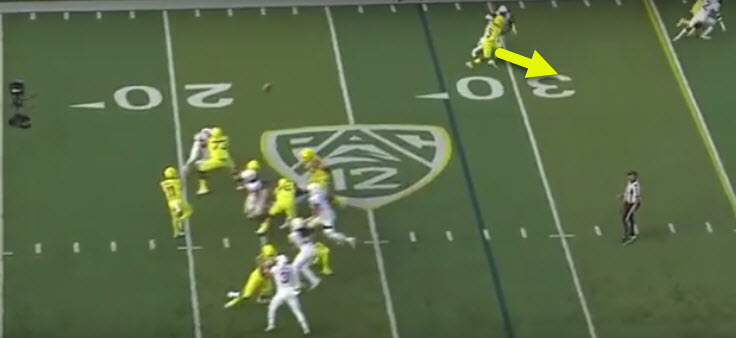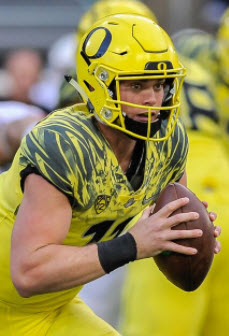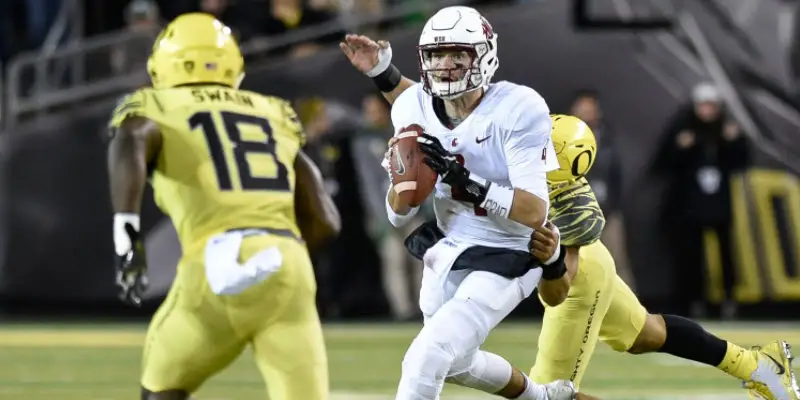Oregon, behind backup quarterback Braxton Burmeister, hung with the Washington State Cougars for three quarters but subsequently went down, 33-10, a score that might have been 49-10 if it weren’t for stellar play by the Duck defense. Burmeister wasn’t given much of a game plan by coach Willie Taggart, but that may not have mattered based on the poor play of the offensive line that had a hard time staying onside and could not stop WSU penetration on run and pass plays.
Next on the dance card is the Stanford Cardinal, which showed its vulnerability earlier in the season with a loss to San Diego State, but has been growing in stature and confidence since, led by the electric running of tailback Bryce Love, who amassed 1,000 yards rushing in only the first four games of this season.
The Ducks’ offensive line never did stop the Cougars from penetrating the line of scrimmage, as they made 11 tackles for loss. In this example above, the play is zone blocked, while the Cougs’ front slants to the right. The Ducks’ right guard’s pad level is too high, and he can’t get his head across the nose tackle. The right tackle is too high also, and worse, can’t cut off the slant of the defensive tackle that lined up on his outside gap.
The Cougars had great luck slanting their defensive ends and in this case, the outside linebacker (No. 33) and middle linebacker (No. 31) come hard off the edge to make sure the running back can’t make a cut back. If this was a read play, the quarterback blew it — he should have pulled the ball and ran it himself.
Stanford’s defense (which lacks the quickness of the best defenses in the Pac-12) is based more on disciplined, physical play and overpowering the blockers, so it might be easier for the Duck offensive line.
Coach Taggart’s gamble to go for it on fourth down, early in the game and inside Duck territory, was stymied by overconfidence in an offensive line that is not very good right now. The gamble got worse on this play, as WSU’s Luke Falk, on his first pass attempt of the game, coolly looked downfield and dumped the ball to his running back who scampered for a 41-yard touchdown.
You can see the Duck defenders on the left side sprint, perhaps too quickly, to their pass responsibilities. Two defenders are still looking to other receivers, unaware that the ball has already been thrown. Bad luck for the Ducks: Jalen Jelks (No. 97), hustling from the pass rush and attempting to tackle the back, cuts the legs out of his own linebacker Blake Rugraff (No. 53), who may have had a chance to make the tackle.
Note that the linebacker lost his outside-in angle on the runner when the running back made a head and shoulder fake inside before cutting towards the sideline. Oregon defenders are going to have to be under control and maintain angles on Stanford’s Love, who is also a dangerous pass receiver for the Cardinal, much like the player he’s replacing this year: Christian McCaffrey.
The above example shows the degree of ineptitude the Ducks displayed with their passing game. Faking a quick screen and go, the slot receiver (No. 80) rushes his fake block and takes off deep, so close to the sideline that there is no room for the quarterback to get him the ball. Although he has a step on the receiver, the ball predictably comes down out of bounds, as did several other deep Burmeister throws.
The quarterback is also rushed on the play because of poor pass protection — the center loses his angle and can’t get his head across the nose tackle that originally lined up over the guard. The right guard, too, can’t block the defensive tackle that also lined up well outside him. The Ducks’ offensive front were defeated by quicker defenders and better athletes who played with low pad levels the entire game.

A different angle could have separated the receiver…
After faking the screen, the wide receiver runs a sloppy post pattern straight up field, making it easy for the corner to cover him. If he had flattened his angle, he would have been alone in the middle of the field, running away from the corner. If the quarterback had the option of throwing to either receiver, the post would have been a higher-percentage, easier-to-complete throw. If the Ducks are going to have a decent passing game, everything on this play needs to change.

Braxton Burmeister
Offensive Line, Passing Game Needs to Improve for Stanford
In the past, Stanford’s offensive and defensive linemen have dedicated the Oregon game as a low-pad level contest. For that reason, the Cardinal are always a physical challenge for the Ducks. Stanford is torn between two quarterbacks and at times, can get bogged down on offense, lacking the firepower that Washington State presented. This should benefit the Duck defensive plan.
The defense is playing well enough to give Oregon a chance to win if the offense can score. Against Stanford, Duck quarterback Braxton Burmeister needs to get a game plan where he can throw the ball downfield and the receivers can catch a simple curl, sideline pass, or give him room to complete a long ball. Unable to establish the pass, jewels such as Royce Freeman will wither in the shadows.
Coach Ken Woody
Eugene, Oregon
Top photo credit: Kevin Cline
Ken Woody is a former Fox Sports football commentator who played defensive back, receiver and kicker for Oregon from 1966 to 1970. He coached college football for 18 years, including stints as an assistant coach at Oregon, Washington, Washington State and Utah State, and was head coach at Whitman College and Washington University-St. Louis.
 Buy the book to learn from Coach Woody, or give a gift of football.
Buy the book to learn from Coach Woody, or give a gift of football.
“Every Oregon fan should have a copy to learn from as I do.” Charles Fischer
Related Articles:
Seven Offensive Coordinator Candidates for the Oregon Ducks
Five Candidates to Replace OC Marcus Arroyo
Coach Jim Mastro: The Perception, and the Truth
Has Oregon Turned the Corner on Offense?
Ducks, Taggart Punish Beavers; Earn Bowling Trip
Textbook Defense, Herbert's Return Energize Duck Victory; Civil War Next
“I learned football working under many great coaches, among them Len Casanova, Jerry Frei, John Robinson, Bruce Snyder, George Seifert,and Ron Stratten at the University of Oregon, Jim Owens at the University of Washington and Jim Walden at Washington State University. Most of my coaching experience was on the offensive side of the ball with quarterbacks, receivers and kickers although as a head coach I coached defensive backs, linebackers and offensive line.
I achieved my first goal of being the youngest head coach in college football at the age of 26 and throughout my career in coaching and outside of it, as a journalist and broadcaster, have experienced how exciting and gratifying it is teaching the game to others.”

